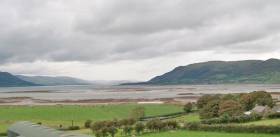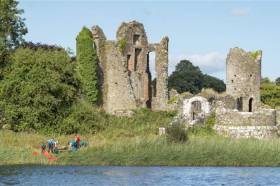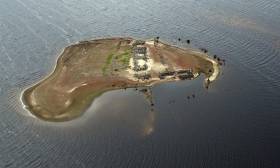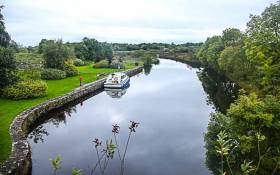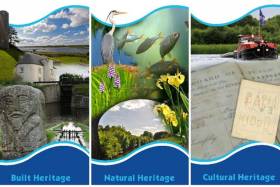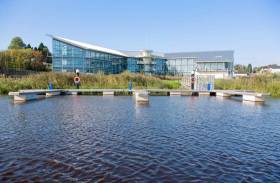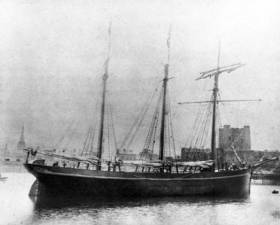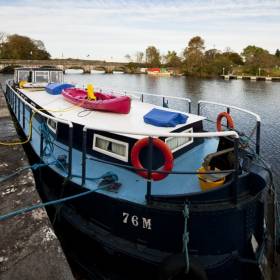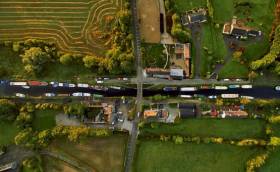Displaying items by tag: heritage
Maritime Heritage Seminars In Foyle & Carlingford This Month
The Loughs Agency has organised two morning seminars around the theme of maritime heritage in the Foyle and Carlingford areas later this month.
The first will take place at Greencastle Golf Club next Friday 22 November from 9.30am to 12.30pm, while Carlingford Marina will host its seminar the following Friday 29 November at the same times.
Both events will include contributions from Patrick Fitzgerald, a professional historian with a long career in researching genealogy and uncovering the story of migration through the centuries, who will take attendees on a journey of migration through the Foyle and Carlingford loughs.
The Greencastle seminar will also hear from Gerald Crawford, former secretary of the Foyle Fisheries Commission, who will tell the story of commercial salmon fishing across two decades Fishing for Salmon in the Foyle.
Retired mariner Seamus Bovaird will be presenting on paddle steamers on Lough Foyle, while Edward Montgomery, secretary of The Honourable The Irish Society, will speak about the society and the Foyle fisheries, and Wes Forsythe, a career archaeologist with an interest in the Foyle area, will presenting on ;Salt and the Sea;.
In Carlingford, Brendan McSherry, Louth County Council’s heritage officer with a passionate awareness of Carlingford Lough, its shores, hinterland and communities, will present on Carlingford Lough, a barrier or a highway?
Kirstin Lemon, geologist by profession with a broader intent to inform communities about their geology and the influence on their culture, will speak about ‘Mountains, Myths and Maritime: a UNESCO Global Geopark in Mourne Gullion Strangford’.
Finally, Liam Campbell, a researcher with an intense interest in exploring the development of cultures within distinct catchments, will present on the ‘Culture of the Catchment – Source to Sea’.
Admission is free free of charge for both events, however tickets must be obtained through Eventbrite to ensure a place at the Foyle and Carlingford seminars respectively.
In other heritage news, the Department of Culture, Heritage and the Gaeltacht has published its report on the public and sectoral meetings held earlier this year on Heritage Ireland 2030, Ireland’s national heritage plan.
Among the issues raised at the sessions in Kilkenny and Galway in February were a lack of joined-up thinking across Government departments with relation to heritage issues, and a recognition of the need to understand heritage in a holistic sense encompassing everything from regional traditions to built heritage and wildlife.
The Lough Erne Landscape Partnership is recruiting for the full-time position of Heritage Project Manager, based in Enniskillen, Co Fermanagh.
The successful candidate will work closely with local project partners, taking the lead on developing and delivering a suite of projects within the Lough Erne Landscape Partnership.
This “exciting” role will enable the right candidate to deliver projects to promote, protect and conserve the built, cultural and natural heritage of the Lough Erne area on and off the waterway.
The closing date for applications is Sunday 27 January. An application pack containing all information on the post is available from the LELP website.
Flooded Homestead Re-emerges From Wicklow Reservoir
#Poulaphuca - The remains of an old homestead submerged by the Poulaphuca Reservoir have resurfaced, as RTÉ News reports.
Images captured by the Garda Air Support Unit in Wicklow clearly show the ruins of a house and a piece of farm machinery.
The ‘island’ was revealed by the retreat of reservoir waters in the recent summer drought that saw remarkable archaeological finds nationwide — as well as an ‘ÉIRE’ sign on Bray Head dating from the Second World War.
While patrolling the Wicklow division The Garda Air Support Unit noticed the ruins of a homestead and a piece of farm machinery (mowing bar) on a raised piece of land which had previously been submerges in the lakes. pic.twitter.com/JIco4vlgit
— An Garda Síochána (@GardaTraffic) September 14, 2018
The farm was one of a number of properties abandoned before the valley was flooded to create Poulaphuca in 1940.
Will Heritage Bill Destroy Navigations it Should be Protecting? – IWAI
The Inland Waterways Association of Ireland (IWAI) will appear today before the Joint Oireachtas Committee on Culture Heritage and the Gaeltacht which is examining the Heritage Bill 2016 Part 2 Canals. In a long running campaign, the IWAI will be calling for legislation that puts user requirements, tourism development and local communities at the centre of the regulations.
'How ironic it would be that a Heritage Bill rather than protecting the future of the Grand and Royal Canals and the Barrow Navigation enables legislation for Bye-laws that end up creating waterways with no boats on them' says John Dolan of the IWAI.
On Tuesday December 5th the Inland Waterways Association of Ireland (IWAI) will appear before the Joint Committee on Culture, Heritage and the Gaeltacht which is examining the Heritage Bill 2016 Part 2 Canals. The is renewing its call to elected representatives to support the IWAI campaign for further revision to the proposed legislation.
The main areas of concern relate to
- • new complicated legal licensing, - rather than the need to legislate for a simple permitting system that is customer friendly, easy to use, and fit for purpose
• Adequate provisions - so that boats of dimensions for which the canals were built to accommodate are protected and can continue to do so into the future
• appropriate charging structures - that matches the provision of services available
• fixed payment notices and fines with no independent appeal mechanism other than the courts, that will not encourage use of the canals and are not in place on the other Irish inland waterways
• proposed provision and powers of Authorised Officers
• legislation that will facilitate the introduction of a complete different set of rules, charges, regulations and fines that are not in place on the adjoining Waterways, and will make these canals less attractive to potential boating tourism
Ireland’s canals as beautiful linear waterways have the potential to attract both domestic and International boating visitors who will relish the tranquil opportunity of slow tourism cruising at walking pace as people move faster than the canal boats on the system, while experiencing the associated industrial heritage, peat lands, small villages and towns that have interdependence with the canals and our capital city.
To achieve this potential it is vital that the Heritage Bill 2016 preserves and enables the development of the canals for the current and future generations and communities. Over regulation and excessive charges are not the answer to developing these waterways, they deserve proper legislation that put user requirements, local communities and tourism at the centre of the regulations.
Heritage In The Community Grant Scheme 2018 Now Open For Waterways Projects
#InlandWaters - In support of the Waterways Ireland Heritage Plan 2016-2020, the Heritage in the Community Grants Scheme for 2018 is now open for applications.
A fund of €20,000 has been allocated to assist community-based heritage projects which compliment or fulfil the delivery of the Waterways Ireland Heritage Plan along the Barrow Navigation, Erne System, Grand Canal, Lower Bann, Royal Canal, Shannon, Shannon-Erne and the Ulster Canal (Upper Lough Erne to Clones).
Applications will be considered from communities seeking assistance for projects related to inland waterways heritage, including data collection and research; good heritage practice in managing sites, collections, objects and more; and supporting fresh approaches and initiatives that link heritage to communities, promoting active engagement.
The deadline for receipt of completed applications, by email or post, is Wednesday 31 January 2018. Further details on the Heritage Grant Scheme are available on the Waterways Ireland website.
Waterways Ireland Archive Open To Visitors This Weekend
#InlandWaters - The Waterways Ireland Archive in Enniskillen is open for tours today and tomorrow (Saturday 9 and Sunday 10 September) as part of the European Heritage Open Days taking place across Northern Ireland this weekend.
From 1pm to 5pm today and tomorrow, visitors can dive into the archives to discover the history of the inland waterways, and explore original archive material.
You'll also get a free tour of the building (tours start at 1pm, 2pm, 3pm and 4pm) which will include the chance to see the solo exhibition ‘Elsewhere’ by artist Douglas Hutton, showcased as part of the Fermanagh Live arts festival.
The exhibition will remain open to the public from 7pm in the evening throughout the festival until Saturday 30 September.
An all-day Belfast–based conference this month entitled 'Our Maritime Heritage: Research, Resources and Restoration' is taking place at Public Record Office of Northern Ireland (PRONI). The first 65 delegates to register here will receive a complimentary lunch. A keynote speaker is Afloat.ie correspondent Marcus Connaughton, the RTE presenter of Seascapes that is podcasted weekly on Afloat.ie.
The conference Thursday 20 October 2016 beginning at 9.30 am and running to 6.00 pm.
The conference explores national, local and individual responses to how we protect our maritime heritage.
This joint conference has been organised by the Public Record Office of Northern Ireland (PRONI), Titanic Foundation Limited, HMS Caroline, National Historic Ships UK, Gerry Brennan (Silvery Light Sailing) and Robin Masefield (author).
The conference explores national, local and individual responses to how we protect our maritime heritage.
Conference at PRONI: 9.30 am-4.15 pm
The conference will commence with a keynote address by Marcus Connaughton, presenter of RTÉ Radio 1’s maritime programme ‘Seascapes’, and Hannah Cunliffe, National Historic Ships UK. Speakers include Gerry Brennan on the Silvery Light project; Christopher Kenny on the schooner Result; Sean Patterson on the Newry Canal and Fishers’ Fleet, Kerrie Sweeney on the development and restoration work on the Harland and Wolff Drawing Offices; Dr Sally Montgomery on the history of Mew Island Lighthouse Optic and its restoration; and Desmond McCabe on maritime research in PRONI archives. Other topics will include the restoration of HMS Caroline, and obtaining project funding. The conference will conclude with an open panel discussion.
Lunch: SS Nomadic
Lunch will be provided on SS Nomadic for the first 65 delegates to register. Remaining delegates will be invited to make their own lunch arrangements.
HMS Caroline visit: 4.15 pm – 6.00 pm
Conclude the day with a visit to HMS Caroline (maximum 80 delegates).
You can see a link for the this event on Afloat's Marine marketplace here
Waterways Ireland To Open Archive For European Heritage Open Days
#InlandWaters - Waterways Ireland will be throwing open the WI Archive to the public on Saturday 10 and Sunday 11 September to celebrate European Heritage Open Days 2016.
Waterways Ireland HQ in Enniskillen will be open between 12pm and 5pm both days next weekend for free guided tours of the archives and building.
All are welcome to pop in for a visit and discover some of the interesting engineering maps, drawings and images of the waterways from the past 150 years.
To find out more email [email protected] or visit the Discover Northern Ireland website to download a brochure on all the special heritage events next weekend.
#InlandWaters - More than 15 of Ireland's unique and hugely significant heritage barges – the Big Boats – are touring the Shannon Blueway, Lough Allen and the North Shannon from this Saturday 23 July till Saturday 6 August.
Organised by the Heritage Boat Association, a programme of public events and activities is planned in conjunction with Waterways Ireland and the communities of Drumshanbo and Leitrim village.
The first activity in the programme takes place on the morning of Friday 29 July as a cargo of coal is delivered by miners from the Arigna mines to a fleet of 12 heritage cargo boats waiting at Drumshambo lock on the Lough Allen Canal.
The public will be able to watch the loading from 10.30am and walk the Shannon Blueway from Drumleague Lock to Battlebridge lock with the boats as they travel along the canal to Acres Lake.
Walkers can also join with the boats at Drumhauver Bridge or Drumleague Lock from 11.30am and walk the rest of the way to Battle Bridge with the Big Boats.
On Saturday 30 July, Leitrim village will host the boats with a festival of music and fun. All are invited to come along and learn about the heritage boats – the same commercial barges that once carried cargos all across the inland waterways of Ireland.
Activities begin at 2pm with talks in Leitrim Village Community Centre and will be followed by a music and a free BBQ sponsored by the Barge Steakhouse. Visitors can come to look at the boats at the Apartment Narina north of Leitrim Village bridge.
The two week trip concludes with a visit to Drumsna on 5-6 August.
The Heritage Boat Association is celebrating the North Shannon navigations and in particular the Lough Allen Canal, which was built almost 200 years ago to carry Arigna coal to the main Shannon navigation.
The Big Boats were the juggernauts of their day and the canals were the highways on which the commerce of the nation depended.
The skippers and crews of the heritage boats are particularly interested in meeting with families who would have had friends or relations who worked on the navigation when it was a commercial waterway.
Full details of the trip and the Heritage Boat Association are available on their website HERE.
Waterways Ireland Launches Heritage Grants Programme
#InlandWaters - Waterways Ireland have announced a Heritage Grants programme in support of its Heritage Plan 2016-2020.
A total of €20,000 has been allocated to help further community-based heritage projects on inland waterways and navigations under the auspices of Waterways Ireland.
Projects must compliment or fulfil the delivery of the Waterways Ireland Heritage Plan, which is available to download HERE.
Application forms with detailed guidelines and eligibility criteria are available in PDF and Microsoft Word formats.
As this is the first year of the grant, contact Cormac McCarthy for any assistance at [email protected] or 061 922 149 or 087 278 7463. The deadline for receipt of applications is Friday 22 April.


























